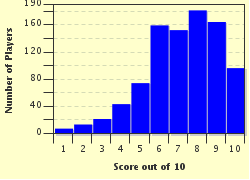Quiz Answer Key and Fun Facts
1. Which of the following has NEVER been suggested as a possible etymological origin for the name Cyprus?
2. Cyprus is the third largest island in the Mediterranean Sea. Which of these islands is one of the two larger islands to be found there?
3. Being an island, Cyprus has no land borders. Which country is its closest neighbour?
4. Which of the following does NOT control one of the four de facto regions of Cyprus?
5. In which part of Cyprus can heavy snowfalls be expected in the winter?
6. Which of these is the most significant environmental issue on Cyprus?
7. Block 12 is an off-shore area that is expected to contain vast deposits of natural gas, which could be a valuable economic resource for Cyprus. It is also known by the name of a Greek goddess reputed to have been born off the shores of Cyprus. What is this nickname?
8. Which of the following symbols of peace is to be found on the flag of Cyprus?
9. The Cypriot coat of arms contains a number of symbols. Which of these is shared with the national flag?
10. In 2004, French archaeologists made a discovery on Cyprus that made zoologists reevaluate the original domestication of one of our most favored pets. What animal is no longer thought to have been originally domesticated in Egypt?
Source: Author
looney_tunes
This quiz was reviewed by FunTrivia editor
Pagiedamon before going online.
Any errors found in FunTrivia content are routinely corrected through our feedback system.


